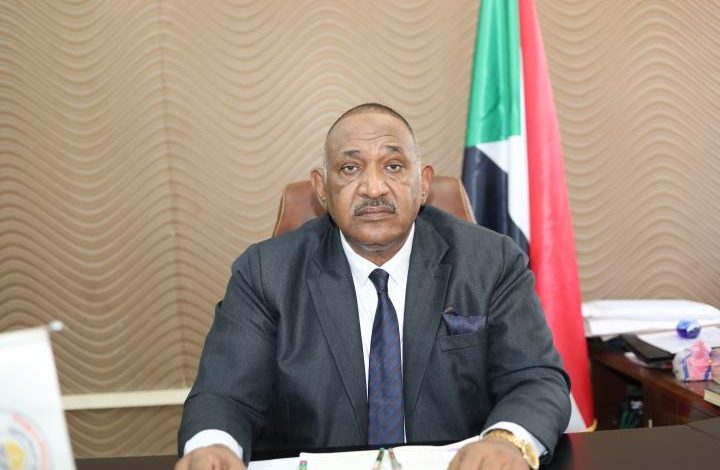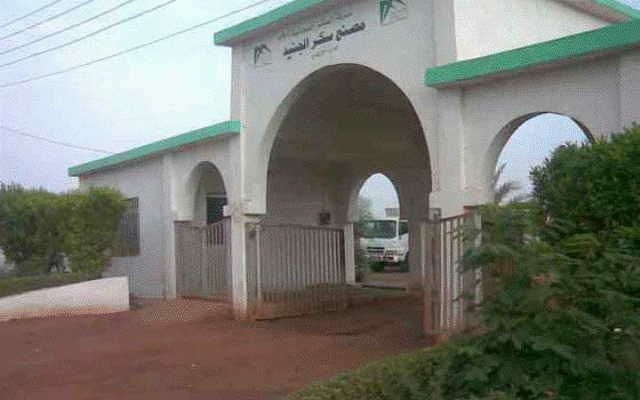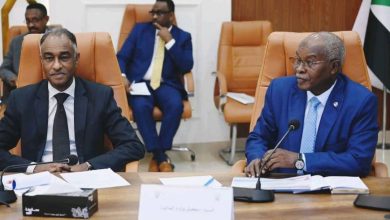Minister of Energy and Oil Dr. Mohi El-Din Naiem in an interview to ( Sudan Events)

Oil production has decreased to less than 20,000 barrels per day
Sudan has an oil reserve of (6) billion barrels, of which we have extracted only 20%
Sudan’s losses from the cessation of southern oil are $150 million
Reconstruction of the oil and electricity sector requires billions of dollars
Sudan Events-Interview – Rehab Abdullah
Minister of Energy and Oil Dr. Mohi El-Din Naiem Mohamed Saeed revealed that the entry of rebel forces into the oil fields caused the disruption of work and led to a decrease in the daily production level from 47,000 barrels to less than 20,000 barrels per day produced by squares (2B) and part of the fields in (2A), throughout the war period, which led to the loss of about (7) million barrels of crude oil, which the country was deprived of producing due to the war.
He affirmed the import of all the country’s fuel needs, which amount to about three million and two hundred thousand tons per year, through free imports.
The minister said that the losses in the refinery so far have exceeded $1 billion , in addition to the amount of crude oil that was burned as a result of the bombing, which is about 300,000 barrels of crude oil.
He added that work is currently underway to more accurately assess the extent of the damage, pointing out that refining has completely stopped due to the war, as the refinery’s crude oil warehouse was destroyed, and other facilities were destroyed, including the gasoline warehouse and the gas warehouse, all of which were full of petroleum products, addition to a group of warehouses of distribution companies located in the control center in Jeili .
The minister affirmed the existence of a wide opportunity to advance the sector through investment, pointing out that Sudan has an oil reserve of about (6) billion barrels, of which only about 20% has been extracted, in addition to the presence of about 12 diverse sedimentary basins and large reserves of natural gas in central and eastern Sudan. He said, “The ministry had previously concluded an EPSA production sharing agreement, under which the Ministry of Energy and Oil and a number of foreign investors became partners in several oil blocks to produce Sudanese oil, including (CNPC of China, Petronas of Malaysia, and ONGC of India).
Some of these oil blocks have completed the time frame of the agreement and have been transferred to the Sudanese government by 100%. More details in his statements below:
What is the extent of the damage that has befallen the oil sector so far as a result of the war between the Rapid Support Militia and the Sudanese army SAF?
The oil sector has been damaged by the war in several aspects, including damage to the body of oil facilities, and other damage represented by the loss of crude oil and petroleum products stored in strategic warehouses from the production of the Khartoum refinery, addition to sabotage and deliberate damage to the fields, theft of cables for wells, camps, workers’ housing, and spare parts stores, and the sabotage of even the buildings of the Ministry of Foreign Affairs.
What is the specific impact on oil production?
Yes, the war has affected oil production, such that the level of production has become very low due to the exit of a number of oil-producing fields from The production cycle due to the war conditions in the country and the entry of rebel forces into these fields and causing disruption of work, which led to a decline in the daily production level from 47,000 barrels to less than (20) thousand barrels per day produced by squares (2B) and part of the fields in (2A), throughout the war period, which led to the loss of about (7) million barrels of crude oil, which the country was deprived of producing due to the war.
How is the country’s need for petroleum products secured?
We import all the country’s need for fuel, which amounts to about 3,302,000 tons per year, through free imports after the private sector companies qualified by the Ministry of Energy and Oil were allowed to import and distribute according to the specifications determined by the ministry according to the international fuel specifications, and since the secession of South Sudan, the country has been completing the shortage of Khartoum Refinery products by importing.
How much were the losses in the Khartoum refinery?
The losses in the refinery so far have exceeded one billion dollars, in addition to the amount of crude oil that was burned as a result of the bombing, which is about 300,000 barrels of crude oil and may increase.
Now, work is underway to more accurately assess the extent of the damage, as refining has stopped completely due to the war, and the refinery’s crude oil warehouse has been destroyed, and other facilities have been destroyed, including the gasoline warehouse and the gas warehouse, all of which were full of petroleum products.
This is in addition to a group of distribution company warehouses located in the control center in Jeili, which are hosted inside the refinery, which has led to the loss of significant quantities of petroleum products for all companies.
How is investment in the oil sector proceeding?
We have a strategic plan to improve the oil sector, a five-year plan (2024 – 2028 ) within the framework of the economic vision that the country seeks after emerging from the war.
We opened opportunities for all companies that previously invested in Sudan and worked to restore confidence in their return to investment.
We also worked to amend many laws that were restrictive and influential in the continuity of investment. It can be said that we have sufficient opportunity to advance the sector, and Sudan has an oil reserve of approximately (6) billion barrels, of which only approximately 20% has been extracted. We have approximately 12 diverse sedimentary basins and large reserves of natural gas in central and eastern Sudan. The Ministry had previously concluded the Production Sharing Agreement (EPSA), under which the Ministry of Energy and Petroleum and a number of foreign investors became partners in several oil blocks to produce Sudanese oil, including (CNPC of China, Petronas of Malaysia, and ONGC of India).
Some of these oil blocks have completed the time frame of the agreement and have been transferred to the Government of Sudan at 100%.
It was a successful and beneficial experience for both parties, and the opportunity is still available for investors wishing to invest in oil in the world and work to increase the capabilities of Sudanese national companies in light of the benefit from the efficiency of Sudanese national cadres who have been managing the Sudanese oil sector at 100% for years.
What is the extent of the damage to southern oil?Is there progress in addressing the southern oil file?
And what is the size of the losses in numbers?
The pumping and flow of crude oil through the Bapco pipeline has stopped since February 12, 2024. As for South Sudan crude, there has been significant damage, which is the stoppage of the flow of crude through Bapco’s oil pipeline to the export terminal in Port Sudan, which led to the shutdown of all oil wells in the southern oil fields in Fallujah field and the fields adjacent to it. Production before the oil wells stopped was about 120 million barrels per day.
This loss is estimated in millions of dollars, especially if the stoppage period is calculated from February 12 until today, and this period is approximately four and a half months, and with simple calculations, the quantities of crude oil can be calculated.
For the Sudanese side, which relies on the return from the transportation tariff agreed upon with the government of the south and the partners, the loss during the above stoppage period amounts to no less than $ 150 million.
As for Bapco’s transmission line, there is significant progress in the repair and the progress rate in the work exceeds 80%.
Work is currently underway at a very fast pace to complete the work, and we expect the repair to be completed very soon. The oil facilities of the transmission line were not damaged and the stoppage in the transfer of crude will freeze the crude inside the line due to the stoppage of the heaters in some pumps due to the lack of gasoline reaching these pumps due to the war, which led to the stoppage of these heaters, which led to the freezing of the crude inside the line, especially after pump No. 4 in the Al-Ailfun area.
What is the extent of the damage to electricity?
As a result of the war waged by the rebel Rapid Support RSF Militia, the electricity sector has been damaged in all its facilities and installations, such as thermal power plants that lost no less than 700 megawatts due to the loss of the Bahri thermal power plants, Qari 1, 2 and 4, and all the stations of the major Darfur states, including private power plants, while the water lost Jebel Awliya power plant due to its location in the areas of clashes.
As for the transmission company, the company lost no less than 800 km of transmission lines of various voltages and a number of large-capacity power transformers in addition to large transformer stations that were completely lost, such as Kabashi transformer station and the Marangan station.
While the distribution network was directly damaged by the destruction of most of the electricity distribution offices and a large number of medium-pressure transformers.
What are the reform efforts in electricity?
The electricity companies have made tremendous efforts in the reform process. Thanks to Allah, and amidst extremely complex and dangerous circumstances, electricity has been connected by restoring a large number of transmission and distribution lines in Khartoum state, Gezira and others.
How much does reconstruction cost in the energy and oil sectors?
We have formed a committee to assess and evaluate the damage caused by the war in the oil and electricity sectors.
The work has reached an estimated phase and the assessment is still ongoing. It has not been completed yet for reasons including the ongoing war in a number of oil sites and facilities. Through the initial assessment, it became clear that the extent of the damage in the oil and electricity sectors is very large.
It is known that oil facilities and power stations are very expensive, and therefore we expect that reconstruction will require billions of dollars for the oil and electricity sectors to return to what they were before.
Work is currently underway at a very rapid pace to complete the work and we expect the repair to be completed very soon.
What are the future plans to protect the sector from external influences and threats and others?
Despite the good planning in the oil sector to study and study future risk flows, the occurrence of the war was completely unexpected as it is one of the elements of force majeure that are difficult to predict or even prevent from occurring. As part of good planning for work during the war, the Ministry of Energy and Oil followed the scenario planning mechanism by developing two plans (A) and (B) in anticipation of any developments, in addition to developing a plan to manage and anticipate risks, as well as engaging in preparing a strategic plan for work after the war stops, in line with Sudan’s economic vision for the post-war period 2024-2028.
In the event that the war ends, we will work on reconstruction, entering the fields that have stopped working, restarting the Khartoum refinery, and resuming work on projects that have stopped working due to the war.
We will work to attract investment to enter into new projects in order to increase oil production, and increasing oil production restores the glories of the oil sector.
How much does Sudan need for electricity consumption?
The demand for electricity has increased steadily in recent years, which required great efforts to meet this demand in all phases of electricity activities such as generation, transmission and distribution.
The maximum load before the war reached more than 3,000 megawatts, and demand is expected to increase by no less than 8% annually.
What are the ministry’s steps regarding the electricity sector to work on stabilising the electricity current?
The ministry and electricity companies have taken practical steps to work on increasing the stability of the electricity current and exploiting resources, by providing resources and aids to the five hydroelectric power plants: Merowe – Atbara and Setit – Roseires – Sennar – Khashm El-Girba, which are operating continuously to date in providing electricity supply and increasing the stability of the national grid, and meeting the shortage in the capacity of the Shendi transformer station by providing an additional transformer, addition to operating the solar power station attached to the North Cement Factory with a capacity of 34 megawatts, which contributed to operating a number of cement factories during the day and reducing the hours of load shedding in the River Nile state, and work is currently underway to provide additional switches for the station to exploit the entire capacity of the solar station amounting to 54 megawatts, which means saving fuel value of no less than $ 15 million annually, in addition to starting extensive campaigns to remove violations and illegal electricity connections (Jabadat), which led to the loss of a large number of transformers due to overloading and the loss of estimated revenues as a result of tampering with meters and random connections.
As for thermal generation, the Thermal Generation Company, the Ministry of Energy and Oil, the Pipelines Company, Bashayer Company, and Petco Company have made tremendous efforts to provide fuel for the Umm Dabaker station, which, after the station is operational, will lead to significant stability in the southern and eastern electricity grid, while maintaining the staff present at the stations under the control of the Rapid Support Forces RSF such as the Bahri and Qari stations, to work on extinguishing the fires that break out from time to time. Work is ongoing to maintain the Port Sudan stations in order to benefit from them in increasing capacity.
As for the Kalanaib electricity project, negotiations are still ongoing with the main contractor and the African Export-Import Bank to resume work on completing the project.



